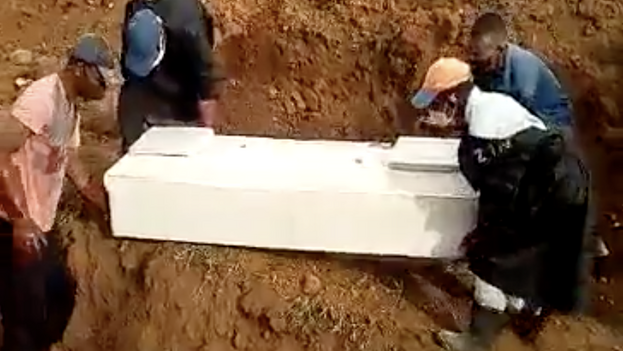
![]() 14ymedio, Havana, 6 August 2021 – Reports of burials in mass graves in Cuba that have circulated through social networks and some independent media, and have been denounced by NGOs such as the Cuban Observatory for Human Rights (OCDH), were denied this Friday with a brief note in the State newspaper Granma that came, as is usual with the official press, late and bad.
14ymedio, Havana, 6 August 2021 – Reports of burials in mass graves in Cuba that have circulated through social networks and some independent media, and have been denounced by NGOs such as the Cuban Observatory for Human Rights (OCDH), were denied this Friday with a brief note in the State newspaper Granma that came, as is usual with the official press, late and bad.
“A minority lacking information, but the majority moved by bad intentions, many people have re-posted images on social media corresponding to the burials of those killed by covid-19, in supposed mass graves, opened in the town of Juan González, 13 miles west of Santiago de Cuba,” says the note, which maliciously designates the unofficial media as “non-independents.”
According to the version of the Communist Party newspaper, the dissemination of information on “the loss of corpses” has led it to interview José Gonzalo Borrero Sotomayor, provincial director of Community Services and a chemical engineer, who assures that the transfer of the bodies has not been — one would say “they have tried to deny it” — improvised and forced by the gravity of the pandemic. Rather, for some time is has responded to the problems of space affecting Santa Ifigenia, the necropolis where the ashes of Fidel Castro are also.
The cemetery was inaugurated in 1868 and has become insufficient for a city that has grown to reach half a million inhabitants. In addition, its location prevents expansion, says Borrero Sotomayor, and is prone to flooding, reasons that have forced an expansion of the Juan González cemetery.
“The necessary use of mechanical means to expand the capacity of the cemetery, existing years ago in Juan González, could generate the impression that informal excavations are being carried out there. However, each operation has been carried out according to the technical standards established for this activity by the Ministry of Economy and Planning,” the official explains.
Burials must be done in such a way that each coffin is covered by 1.5 meters of earth or, in the case of graves that house several, respecting the same distance between the upper part of one and the lower part of the other. “All this is fulfilled to the letter,” since it is a matter that requires the greatest sensitivity, says Borrero Sotomayor.
The manager assures that no body has been lost and adds that the works to expand the burial capacity in Santiago de Cuba had been underway for a long time before the pandemic reached the island. The one that is most advanced will be located in an area known as Hicaco, on the Siboney highway and, although it is designed to house 10,000 bodies, in a few months its first block, of 365 graves, will be finished.
The other projected cemetery will be located at kilometer 10 of the Central Highway in the direction of El Cobre. Once the time for the exhumation* has elapsed, the remains of family members can be transferred from Juan González to these facilities, according to Granma.
Roberto Alejandro Ibarra Ruiz published on August 1 on his Facebook wall a video in which a group of gravediggers was seen burying two coffins in a mass grave allegedly located in that necropolis.
“On July 24, I buried my grandmother in the Juan González cemetery and, as you can see in the video, they are burying her in a grave, mixed with the people who died of Covid-19, when she did not suffer from that disease. So, what are we talking about? How long are we going to continue living on lies?” he wrote.
Ibarra’s publication sought to respond to the official television presenter, Humberto López, who assured that a similar complaint was a hoax that used images from Brazil to make them pass for a cemetery in Cuba. With the video of his grandmother’s funeral, Ibarra questioned the reporter and demanded that he show the video, but got no response.
Granma claims to have spoken with the young man and clarified with him that the burial had taken place in row 4, pit 16, and not as he suggested, although the young man’s version is unconfirmed, since he has not published anything else since that day.
*Translator’s note: In Cuba it is common practice, after a certain time has passed, to move human remains from the grave they were buried in to mausoleum and reuse the original grave. This is described in a note on Colon Cemetery in Havana: “While it is the final resting place for the vast majority of those who were buried here, it’s not final for everyone. Recent burials in the cemetery only remain in the ground for three years, after which they are exhumed and laid to rest in a specially constructed building.”
____________
COLLABORATE WITH OUR WORK: The 14ymedio team is committed to practicing serious journalism that reflects Cuba’s reality in all its depth. Thank you for joining us on this long journey. We invite you to continue supporting us by becoming a member of 14ymedio now. Together we can continue transforming journalism in Cuba.
